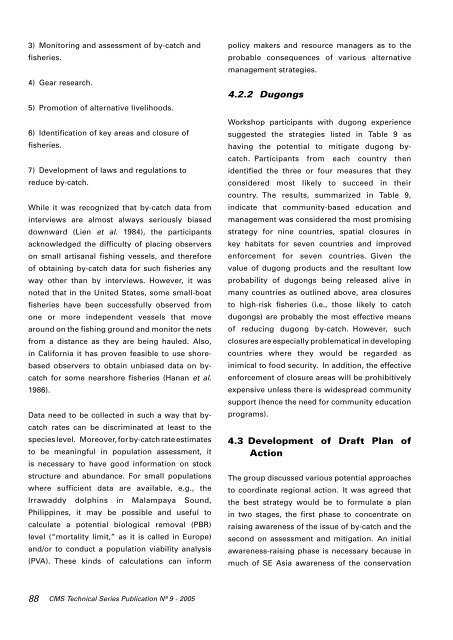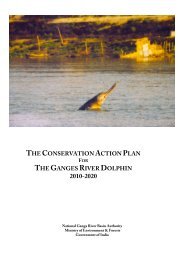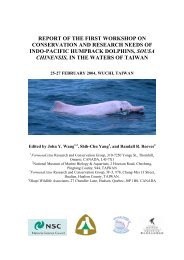Report of the Second Workshop on The Biology and Conservation of ...
Report of the Second Workshop on The Biology and Conservation of ...
Report of the Second Workshop on The Biology and Conservation of ...
You also want an ePaper? Increase the reach of your titles
YUMPU automatically turns print PDFs into web optimized ePapers that Google loves.
3) M<strong>on</strong>itoring <strong>and</strong> assessment <str<strong>on</strong>g>of</str<strong>on</strong>g> by-catch <strong>and</strong>fisheries.4) Gear research.5) Promoti<strong>on</strong> <str<strong>on</strong>g>of</str<strong>on</strong>g> alternative livelihoods.6) Identificati<strong>on</strong> <str<strong>on</strong>g>of</str<strong>on</strong>g> key areas <strong>and</strong> closure <str<strong>on</strong>g>of</str<strong>on</strong>g>fisheries.7) Development <str<strong>on</strong>g>of</str<strong>on</strong>g> laws <strong>and</strong> regulati<strong>on</strong>s toreduce by-catch.While it was recognized that by-catch data frominterviews are almost always seriously biaseddownward (Lien et al. 1984), <str<strong>on</strong>g>the</str<strong>on</strong>g> participantsacknowledged <str<strong>on</strong>g>the</str<strong>on</strong>g> difficulty <str<strong>on</strong>g>of</str<strong>on</strong>g> placing observers<strong>on</strong> small artisanal fishing vessels, <strong>and</strong> <str<strong>on</strong>g>the</str<strong>on</strong>g>refore<str<strong>on</strong>g>of</str<strong>on</strong>g> obtaining by-catch data for such fisheries anyway o<str<strong>on</strong>g>the</str<strong>on</strong>g>r than by interviews. However, it wasnoted that in <str<strong>on</strong>g>the</str<strong>on</strong>g> United States, some small-boatfisheries have been successfully observed from<strong>on</strong>e or more independent vessels that movearound <strong>on</strong> <str<strong>on</strong>g>the</str<strong>on</strong>g> fishing ground <strong>and</strong> m<strong>on</strong>itor <str<strong>on</strong>g>the</str<strong>on</strong>g> netsfrom a distance as <str<strong>on</strong>g>the</str<strong>on</strong>g>y are being hauled. Also,in California it has proven feasible to use shorebasedobservers to obtain unbiased data <strong>on</strong> bycatchfor some nearshore fisheries (Hanan et al.1986).Data need to be collected in such a way that bycatchrates can be discriminated at least to <str<strong>on</strong>g>the</str<strong>on</strong>g>species level. Moreover, for by-catch rate estimatesto be meaningful in populati<strong>on</strong> assessment, itis necessary to have good informati<strong>on</strong> <strong>on</strong> stockstructure <strong>and</strong> abundance. For small populati<strong>on</strong>swhere sufficient data are available, e.g., <str<strong>on</strong>g>the</str<strong>on</strong>g>Irrawaddy dolphins in Malampaya Sound,Philippines, it may be possible <strong>and</strong> useful tocalculate a potential biological removal (PBR)level (“mortality limit,” as it is called in Europe)<strong>and</strong>/or to c<strong>on</strong>duct a populati<strong>on</strong> viability analysis(PVA). <strong>The</strong>se kinds <str<strong>on</strong>g>of</str<strong>on</strong>g> calculati<strong>on</strong>s can informpolicy makers <strong>and</strong> resource managers as to <str<strong>on</strong>g>the</str<strong>on</strong>g>probable c<strong>on</strong>sequences <str<strong>on</strong>g>of</str<strong>on</strong>g> various alternativemanagement strategies.4.2.2 Dug<strong>on</strong>gs<str<strong>on</strong>g>Workshop</str<strong>on</strong>g> participants with dug<strong>on</strong>g experiencesuggested <str<strong>on</strong>g>the</str<strong>on</strong>g> strategies listed in Table 9 ashaving <str<strong>on</strong>g>the</str<strong>on</strong>g> potential to mitigate dug<strong>on</strong>g bycatch.Participants from each country <str<strong>on</strong>g>the</str<strong>on</strong>g>nidentified <str<strong>on</strong>g>the</str<strong>on</strong>g> three or four measures that <str<strong>on</strong>g>the</str<strong>on</strong>g>yc<strong>on</strong>sidered most likely to succeed in <str<strong>on</strong>g>the</str<strong>on</strong>g>ircountry. <strong>The</strong> results, summarized in Table 9,indicate that community-based educati<strong>on</strong> <strong>and</strong>management was c<strong>on</strong>sidered <str<strong>on</strong>g>the</str<strong>on</strong>g> most promisingstrategy for nine countries, spatial closures inkey habitats for seven countries <strong>and</strong> improvedenforcement for seven countries. Given <str<strong>on</strong>g>the</str<strong>on</strong>g>value <str<strong>on</strong>g>of</str<strong>on</strong>g> dug<strong>on</strong>g products <strong>and</strong> <str<strong>on</strong>g>the</str<strong>on</strong>g> resultant lowprobability <str<strong>on</strong>g>of</str<strong>on</strong>g> dug<strong>on</strong>gs being released alive inmany countries as outlined above, area closuresto high-risk fisheries (i.e., those likely to catchdug<strong>on</strong>gs) are probably <str<strong>on</strong>g>the</str<strong>on</strong>g> most effective means<str<strong>on</strong>g>of</str<strong>on</strong>g> reducing dug<strong>on</strong>g by-catch. However, suchclosures are especially problematical in developingcountries where <str<strong>on</strong>g>the</str<strong>on</strong>g>y would be regarded asinimical to food security. In additi<strong>on</strong>, <str<strong>on</strong>g>the</str<strong>on</strong>g> effectiveenforcement <str<strong>on</strong>g>of</str<strong>on</strong>g> closure areas will be prohibitivelyexpensive unless <str<strong>on</strong>g>the</str<strong>on</strong>g>re is widespread communitysupport (hence <str<strong>on</strong>g>the</str<strong>on</strong>g> need for community educati<strong>on</strong>programs).4.3 Development <str<strong>on</strong>g>of</str<strong>on</strong>g> Draft Plan <str<strong>on</strong>g>of</str<strong>on</strong>g>Acti<strong>on</strong><strong>The</strong> group discussed various potential approachesto coordinate regi<strong>on</strong>al acti<strong>on</strong>. It was agreed that<str<strong>on</strong>g>the</str<strong>on</strong>g> best strategy would be to formulate a planin two stages, <str<strong>on</strong>g>the</str<strong>on</strong>g> first phase to c<strong>on</strong>centrate <strong>on</strong>raising awareness <str<strong>on</strong>g>of</str<strong>on</strong>g> <str<strong>on</strong>g>the</str<strong>on</strong>g> issue <str<strong>on</strong>g>of</str<strong>on</strong>g> by-catch <strong>and</strong> <str<strong>on</strong>g>the</str<strong>on</strong>g>sec<strong>on</strong>d <strong>on</strong> assessment <strong>and</strong> mitigati<strong>on</strong>. An initialawareness-raising phase is necessary because inmuch <str<strong>on</strong>g>of</str<strong>on</strong>g> SE Asia awareness <str<strong>on</strong>g>of</str<strong>on</strong>g> <str<strong>on</strong>g>the</str<strong>on</strong>g> c<strong>on</strong>servati<strong>on</strong>88 CMS Technical Series Publicati<strong>on</strong> Nº 9 - 2005





